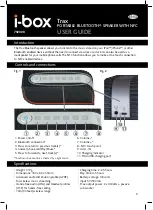
9
TD-001517-01
K.2 Series Service Manual
3.3 Test Mode application
In some cases it may be useful to place the amplifier module into “Test Mode” for bench testing or troubleshooting. To
enable Test Mode, use the K.2 Test Mode application on a Windows OS.
Enabling Test Mode removes DSP limiting, voicing, and EQ. This allows us to test the amplifier module to full power specifi-
cations. Please keep in mind the following when using Test Mode:
• DSP limiting is disabled, which allows the maximum output voltage and power to both channels.
• DSP voicing and EQ (including the 2▲kHz crossover between channels) is disabled. All frequencies can pass through both
LF and HF output channels, providing a mostly flat response output.
• Test Mode should only be used when the amplifier module is disconnected from the K.2 speaker enclosure (effectively
disconnecting the LF and HF transducers from the system).
If Test Mode is enabled when the drivers are connected to the
amplifier module and an active input signal is present, there is a risk of damaging the drivers!
Requirements
The hardware and software requirements for the Test Mode application are similar to the K.2 Updater application.
• Windows PC only (native MAC OS not supported)
• USB Type A to microUSB cable
• AC power cord
Test Mode functions by page
Page / Function
Description
TEST MODE
TEMP
External temperature reading from temperature sensor (location U8 on the AMP/PSU board, bottom side nearest the heatsink).
MCU TEMP
Internal temperature reading in the Cortex microcontroller die (location U2 on the input/DSP board).
ACV
AC voltage reading from AC voltage monitor circuit (location U9 on AMP/PSU board).
STAND BY
AUTO
(Default). Start-up timer, AC dead zone, and DC dead zone will places amps in standby. (Not the same as normal Standby mode.)
AMPS ON
Amplifiers always on. Ignore any condition that can put the amplifiers in standby mode.
FAN MODE
OFF
Fan all the way off - 0%
LOW
Fan at low speed - 50%
HIGH
(Default) Fan at high speed - 100%
TEMP TEST
OFF
(Default) Temperature test off.
START
Run temperature test. During the test the DSP applies a high level pink noise to the amp channels while the temperature is
measured for 45 seconds. If temperature significantly increases, returns a “Pass”. If temperature does not increase, returns a “Fail”.
Primarily used to determine if the temperature sensor U8 is working, but can also be useful to check output.
BURN IN
OFF
(Default) Burn in test off.
ON
Burn in test on. Commands the DSP to apply a high level pink noise to both amp channels (no timeout).
POWER TEST
OFF
(Default) Power test off.
ON
Power test on. Adds an LF RMS limiter through the DSP signal path and connects the limit LED to that limiter. The mode allows for
long term power testing.
CROSSOVER TEST
Should be renamed to “Cross Talk Test”.
BOTH
(Default) Both channels on.
HF / LF OFF
High frequency channel ON. Low frequency channel OFF.
LF / HF OFF
Low frequency channel ON. High frequency channel OFF.
POWER SCREEN
+15V, -15V, 3.3V, 5.0V
Measures power rails. If the ±15V rails drop below ±12.3V in RUN mode, this could cause the +12VLOW voltage rails to drop to
8-9V, which causes major issues in the amplifier MOSFET gate drivers. In Standby mode, this voltage naturally drops to 8-9V because
the PSU is in “Passive (RC) Clamp” mode. The 3.3V and 5.0V rails should be steady and not swing by more than 100mV.
Proceed with caution while in Test Mode
Summary of Contents for K.2 series
Page 2: ...2 QSC LLC...










































